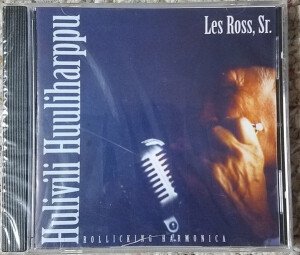 Judith Gennett wrote this review.
Judith Gennett wrote this review.
Les Ross is a retired accountant from Marquette, Michigan who plays harmonica in traditional Finnish-American lumberjack style. This album was made when Ross was in his mid-seventies, but the playing is as wonderful and young as that of a teenager in the Blue Moon Tavern. Now in 2002, nearing 80, Ross still plays at festivals like this years Finnfest in Minneapolis.
A Finnish musician once said, “We play major, people say we sound Swedish, we play minor, we sound Russian.” On this album of mostly dance tunes, the split is more between polka and Russian. Polka-zabava style backing by Les Ross Jr’s Finnish-reggae band Conge Se Menne on many tunes gives Ross’ playing a sort of contemporary Brave Combo punky sound. The premier fun dance tune on this album, the minor key “Vera ja Seppan Salli/Vera and the Blacksmith” is like this; Ross refers to this as “Schottishe Rock.” On the other hand, the fast A flat minor “Sakkijarven Polkka” is accompanied by something that sounds like hand claps. With the intermittent “Hei!!!”s, it is very much like the CanUkranian zabava tunes, (if you’re into that sort of thing)! Maybe the similarity comes from Finland having been part of Russia for a century, and some of it (of course), still is. There are also slower waltzes on the album, where the “violining” of Mary Syria stands out.
Some tracks feature vocals by UP (Upper Peninsula) singers. Tanya Jurvalin-Stanaway adds almost childlike vocals, reminiscent of the great UP accordionist Viola Turpeinen, to the love song “Emma.” Darrell Syria sings an incredibly fast and short “Kurikan Jussi/John from Kurikka.” This is a eulogy for a well known UP pulp cutter and peeler, emigrated from Kurikka, which I think is somewhere around the port of Vaasa. Ross plays just as fast. “Tuli Tuli Talvi/Come Come Winter” is sung by Ross himself and is about a guy who spends too much time thinking about women but neglects to fix his cabin for winter. All these vocals are in a matter-of-fact style, with no presumptive vocal acrobatics.
It is Ross’ complex harmonica style that holds the album together. Like lone dance fiddlers, he carries several parts on the harmonica; this is what they call “lumberjack style.” Aside from the dance tunes, he does “Tummat Silmat/Dark Eyes,” solo, and it gets faster and faster. Another tune that sounds like a train is “#97 Unan Onnettomuus/Wreck Of the Old 97.”
I’ve been told that Finnish-American music is insular. I’ve been told that Finns may not hug you when you arrive but that they won’t talk about you when you leave either. In any event, Finnish-American music is not well publicized, but when you do find it, it is a joy and not all that “different” and inaccessible to American tastes. This album in particular is skillfully made and on top of things, and especially warm and a lot of fun.
Learn more about Les Ross Sr., here.
(Conga Musiikka Oy, 1998)
